|
Notes: Muswell Hill Station had two side platforms and a substantial brick street-level building on the north side of Muswell Hill at the back of a small forecourt. With the coming of residential development around the station in the early twentieth century a second entrance to the station was opened along a footpath from Duke's Avenue for use at peak times. A lattice iron footbridge spanning the platforms was also constructed close to this entrance.
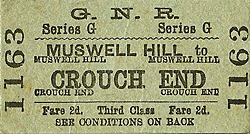 There was a two road goods yard, mainly for coal, on the up side of the line and a single siding on the down side running behind the north end of the platform. Access to the yard was a short distance down Muswell Hill and the yard was at a slightly lower level at its south end. The 1956 map reproduced below shows this siding had been removed and one of the sidings in the goods yard had been realigned. Muswell Hill station was the busiest on the branch and was fitted with a passimeter booking office in 1927. There was a two road goods yard, mainly for coal, on the up side of the line and a single siding on the down side running behind the north end of the platform. Access to the yard was a short distance down Muswell Hill and the yard was at a slightly lower level at its south end. The 1956 map reproduced below shows this siding had been removed and one of the sidings in the goods yard had been realigned. Muswell Hill station was the busiest on the branch and was fitted with a passimeter booking office in 1927.
After opening on 24 May 1873 the station closed several weeks later on 1 August after a fire gutted Alexandra Palace. The station reopened on 1 May 1875. There was a further short period of closure between 29 October 1951 and 7 January 1952. After closure to passengers in 1954 the station remained open for freight traffic until 14 June 1956. The track was lifted by 1958 and the station buildings were demolished by 1960 when the weight restricted Muswell Hill road bridge was filled in to allow the operation of double deck buses. The platforms were demolished c1965. The last passenger train to call at Muswell Hill was the The Locomotive Club of Great Britain (London Branch) Poplar & Edgware railtour on 5 May 1956.
As part of the 'New Works' plan to incorporate the Alexandra Palace branch into London Transport's Northern Line a large brick electricity sub-station was built at the back of the goods yard. This was fully equipped but never used and was demolished along with the station in the early 1960s when Muswell Hill Primary School was built on the site in the 1960s. There is a feature on the station on the school web site.
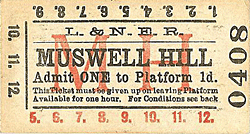 BRIEF HISTORY OF THE FINSBURY PARK TO ALEXANDRA PALACE LINE BRIEF HISTORY OF THE FINSBURY PARK TO ALEXANDRA PALACE LINE
The Edgware, Highgate & London Railway obtained an Act in 1862 to build a line from a junction with the GNR at Seven Sisters Road station (now Finsbury Park) to Edgware. The following year the Midland Railway received authority to build a line between Bedford and St Pancras which would provide a quicker route into central London from the Mill Hill area. To improve the prospects of their Edgware line the EH&LR proposed a branch from Highgate to Muswell Hill serving the new Alexandra Palace and its pleasure grounds – a ‘leisure complex’ in modern idiom - and an extension of the main line from Edgware to Watford.
Both proposals were approved by Parliament in 1864 as was a further branch from Finchley to High Barnet in 1866. In 1866 a further Act was obtained by the independent The Muswell Hill & Palace Railway to extend the branch from Muswell Hill to a terminus adjoining the Palace.
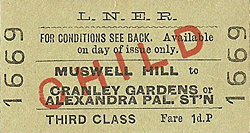
The ‘main line’ between Seven Sisters Road and Edgware proved more costly than expected, and shortly before completion the local company was taken over by the Great Northern who opened the line on 22 August 1867 with intermediate stations at Crouch End, Highgate, East End Finchley, Finchley, Hendon and Mill Hill; but the extension to Watford was never built. On 1 April 1872 the High Barnet branch was opened with the Alexandra Palace branch following on 24 May 1873; the section between Muswell Hill and Alexandra Palace was still owned by the Muswell Hill & Palace Railway although it was worked by the GNR. The Alexandra Palace branch was an immediate success, providing the most convenient route to the Palace from central London, but the services were suspended a few weeks after opening when the palace was gutted by fire and they were not reinstated until May 1875. Despite its initial success, within a year the MH&PR was in financial difficulty as passenger numbers fell dramatically. Several periods of closure for the terminus followed as the GNR failed to attract residential traffic to the line. Suburban growth on the main line as far as Finchley began in the 1860s and a further station at Stroud Green was opened on 11 April 1881. Residential traffic between Muswell Hill and Highgate was also improving, and an additional station at Cranley Gardens was opened in 1902, but Alexandra Palace station continued to be underused.
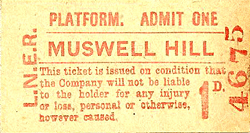 In 1911 the Muswell Hill & Palace Railway was purchased by the GNR, and although passenger numbers had improved this was halted by competition from the new, more convenient, tram services. Through trains to central London outside the rush hour were withdrawn during WW1 when a weekday shuttle between Finsbury Park and Alexandra Palace was introduced. Although the full weekday service was restored at the end of the war the branch never fully recovered and passenger numbers at all stations between Highgate and Alexandra Palace markedly declined. In 1911 the Muswell Hill & Palace Railway was purchased by the GNR, and although passenger numbers had improved this was halted by competition from the new, more convenient, tram services. Through trains to central London outside the rush hour were withdrawn during WW1 when a weekday shuttle between Finsbury Park and Alexandra Palace was introduced. Although the full weekday service was restored at the end of the war the branch never fully recovered and passenger numbers at all stations between Highgate and Alexandra Palace markedly declined.
In 1935 the London Passenger Transport Board announced their 'New Works Plan' which included a proposal to take over the ex-GNR line between Finsbury Park and Edgware and High Barnet, including the Alexandra Palace branch. These would be incorporated into the Northern Line, with a new connection with the Northern City line at Finsbury Park providing a fast and frequent service of electric trains into central London.
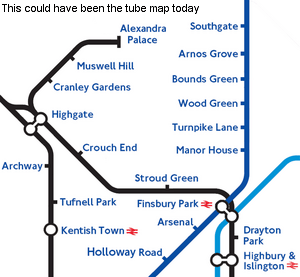 The plan was adopted and shortly before the start of WW2 the lines began to appear on underground maps. It was expected that Northern Line trains would be running into Alexandra Palace by 1940. Work on the electrification and new infrastructure started alongside the steam service which continued to operate. The plan was adopted and shortly before the start of WW2 the lines began to appear on underground maps. It was expected that Northern Line trains would be running into Alexandra Palace by 1940. Work on the electrification and new infrastructure started alongside the steam service which continued to operate.
With the start of WW2 the service was once again reduced. Although work on the electrification of the Alexandra Palace branch ceased in 1940 some work continued north of Highgate on the Edgware and High Barnet lines. London Transport had every intention of completing their New Works plan and although several lines, including the Alexandra Palace branch, were shown to be 'under construction' on some underground maps until 1950, work was never resumed. On 3 July 1939 the existing northern line service was extended from Archway to East Finchley where it surfaced alongside the LNER line from Finsbury Park just south of the station. The steam train service which formerly served High Barnet and Edgware was cut back to East Finchley, and after March 1941 all trains were diverted to Alexandra Palace instead; but this improvement in the service was short-lived as all through trains were withdrawn and, once again, a limited shuttle replaced them.
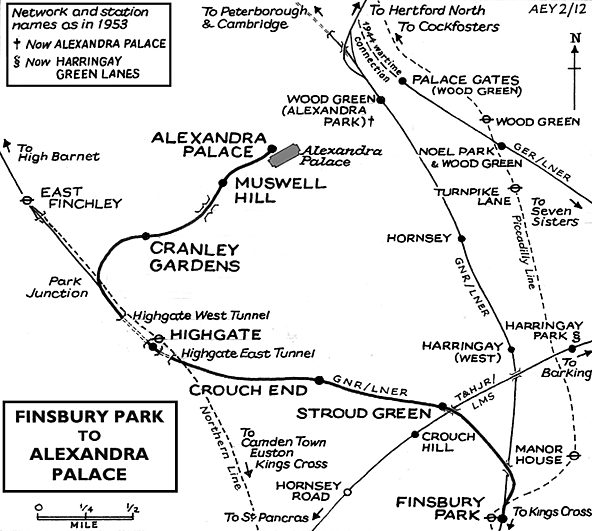
Through services to Kings Cross were reinstated after the war but were suspended to save coal between 29 October 1951 and 7 January 1952. After local pressure a peak hour-only service using Victorian locomotives and ancient rolling stock was reinstated, but it was clear that final closure was inevitable. It was announced in 1953 that the line would close as the number of passengers did not justify its electrification – not that electrification of the main line from Kings Cross was itself being seriously considered. A shuttle service continued until 3 July 1954 when all stations closed to passenger traffic.
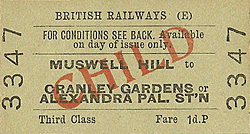 Freight traffic continued to serve Muswell Hill until 14 June 1956, and Cranley Gardens until 18 May 1957 after which date the line north of Park Junction was abandoned. The conductor rails were removed between January 1954 and February 1955 and the track north of Park Junction was lifted by early 1958. The section of line between Finsbury Park and Highgate remained open to freight traffic with Highgate and High Barnet remaining open until 1 October 1962 and Edgware until 1 June 1964 Freight traffic continued to serve Muswell Hill until 14 June 1956, and Cranley Gardens until 18 May 1957 after which date the line north of Park Junction was abandoned. The conductor rails were removed between January 1954 and February 1955 and the track north of Park Junction was lifted by early 1958. The section of line between Finsbury Park and Highgate remained open to freight traffic with Highgate and High Barnet remaining open until 1 October 1962 and Edgware until 1 June 1964
The line was also used for a weekly transfer of tube stock between Drayton Park and Highgate Wood sidings until 29 September 1970, with trains being hauled by LT battery locomotives. This eventually ceased because of the condition of a bridge and the flyover above the main line north of Finsbury Park. The reaming track was lifted in January 1972.
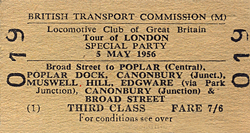 Before final closure the line had been used as an unofficial walkway. The section between Cranley Gardens and Alexandra Park, including the St James Lane viaduct, was adopted as a Parkland Walk by Haringey Council in 1976 and the section between Finsbury Park and Highgate was similarly adopted a few years later. The Parkland Walk was officially opened in 1984 following extensive re-surfacing and improvements to access. The 3.9 mile walkway and cycleway is divided into two sections - Finsbury Park to Highgate and Cranley Gardens to Muswell Hil -l and is now London's longest nature reserve and is incorporated into the 78-mile ‘Capital Ring’ Before final closure the line had been used as an unofficial walkway. The section between Cranley Gardens and Alexandra Park, including the St James Lane viaduct, was adopted as a Parkland Walk by Haringey Council in 1976 and the section between Finsbury Park and Highgate was similarly adopted a few years later. The Parkland Walk was officially opened in 1984 following extensive re-surfacing and improvements to access. The 3.9 mile walkway and cycleway is divided into two sections - Finsbury Park to Highgate and Cranley Gardens to Muswell Hil -l and is now London's longest nature reserve and is incorporated into the 78-mile ‘Capital Ring’
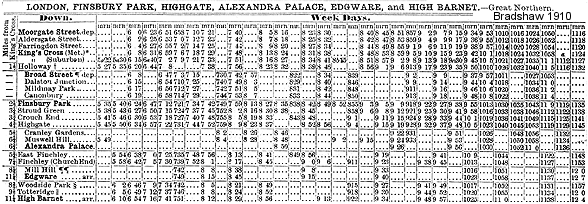
Tickets from Michael Stewart except 019 Brian Halford, Bradshaw from Chris Totty. Route map drawn by Alan Young.
Main historical source: London Railway Record No's. 6 & 7 (January & April 1996) published by Connor & Butler.
Further reading: Northern Wastes by Jim Blake and Jonathan James published 1987 by North London Transport Society ISBN 0 3267304 02
Other web sites: Northern Heights - includes many pictures of the line in April 1970
Piccadilly line.org.uk web site, Underground History web site, Abandoned tube stations web site,
Urban 75 web site & A wander along the Northern Heights.
To see other Stations on the Finsbury Park - Alexandra Palace line click on the station name: Finsbury Park, Stroud Green, Crouch End, Highgate, Cranley Gardens & Alexandra Palace |

old5.jpg)
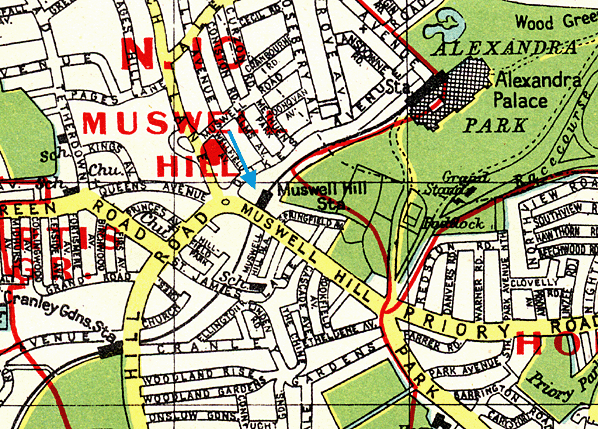
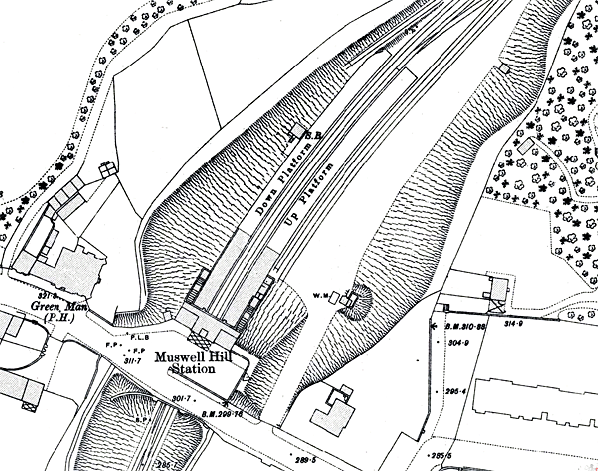
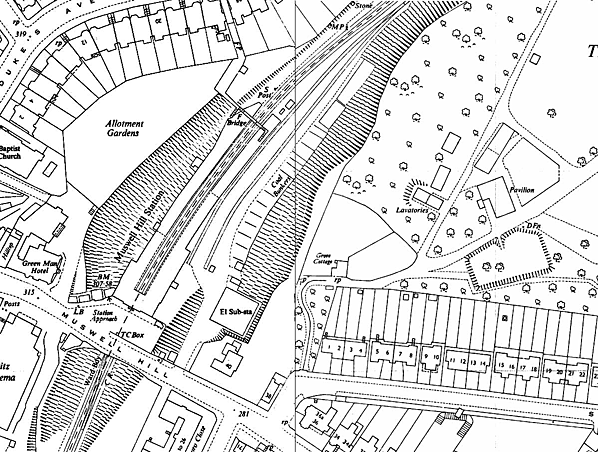
old3.jpg)
old11.jpg)
old2.jpg)
old11.jpg)
old9.jpg)
old4.jpg)
old8.jpg)
old7.jpg)
4.jpg)
3.jpg)
 There was a two road goods yard, mainly for coal, on the up side of the line and a single siding on the down side running behind the north end of the platform. Access to the yard was a short distance down Muswell Hill and the yard was at a slightly lower level at its south end. The 1956 map reproduced below shows this siding had been removed and one of the sidings in the goods yard had been realigned. Muswell Hill station was the busiest on the branch and was fitted with a passimeter booking office in 1927.
There was a two road goods yard, mainly for coal, on the up side of the line and a single siding on the down side running behind the north end of the platform. Access to the yard was a short distance down Muswell Hill and the yard was at a slightly lower level at its south end. The 1956 map reproduced below shows this siding had been removed and one of the sidings in the goods yard had been realigned. Muswell Hill station was the busiest on the branch and was fitted with a passimeter booking office in 1927. BRIEF HISTORY OF THE FINSBURY PARK TO ALEXANDRA PALACE LINE
BRIEF HISTORY OF THE FINSBURY PARK TO ALEXANDRA PALACE LINE
 In 1911 the Muswell Hill & Palace Railway was purchased by the GNR, and although passenger numbers had improved this was halted by competition from the new, more convenient, tram services. Through trains to central London outside the rush hour were withdrawn during WW1 when a weekday shuttle between Finsbury Park and Alexandra Palace was introduced. Although the full weekday service was restored at the end of the war the branch never fully recovered and passenger numbers at all stations between Highgate and Alexandra Palace markedly declined.
In 1911 the Muswell Hill & Palace Railway was purchased by the GNR, and although passenger numbers had improved this was halted by competition from the new, more convenient, tram services. Through trains to central London outside the rush hour were withdrawn during WW1 when a weekday shuttle between Finsbury Park and Alexandra Palace was introduced. Although the full weekday service was restored at the end of the war the branch never fully recovered and passenger numbers at all stations between Highgate and Alexandra Palace markedly declined.  The plan was adopted and shortly before the start of WW2 the lines began to appear on underground maps. It was expected that Northern Line trains would be running into Alexandra Palace by 1940. Work on the electrification and new infrastructure started alongside the steam service which continued to operate.
The plan was adopted and shortly before the start of WW2 the lines began to appear on underground maps. It was expected that Northern Line trains would be running into Alexandra Palace by 1940. Work on the electrification and new infrastructure started alongside the steam service which continued to operate. 
 Freight traffic continued to serve Muswell Hill until 14 June 1956, and Cranley Gardens until 18 May 1957 after which date the line north of Park Junction was abandoned. The conductor rails were removed between January 1954 and February 1955 and the track north of Park Junction was lifted by early 1958. The section of line between Finsbury Park and Highgate remained open to freight traffic with Highgate and High Barnet remaining open until 1 October 1962 and Edgware until 1 June 1964
Freight traffic continued to serve Muswell Hill until 14 June 1956, and Cranley Gardens until 18 May 1957 after which date the line north of Park Junction was abandoned. The conductor rails were removed between January 1954 and February 1955 and the track north of Park Junction was lifted by early 1958. The section of line between Finsbury Park and Highgate remained open to freight traffic with Highgate and High Barnet remaining open until 1 October 1962 and Edgware until 1 June 1964  Before final closure the line had been used as an unofficial walkway. The section between Cranley Gardens and Alexandra Park, including the St James Lane viaduct, was adopted as a Parkland Walk by Haringey Council in 1976 and the section between Finsbury Park and Highgate was similarly adopted a few years later. The Parkland Walk was officially opened in 1984 following extensive re-surfacing and improvements to access. The 3.9 mile walkway and cycleway is divided into two sections - Finsbury Park to Highgate and Cranley Gardens to Muswell Hil -l and is now London's longest nature reserve and is incorporated into the 78-mile ‘Capital Ring’
Before final closure the line had been used as an unofficial walkway. The section between Cranley Gardens and Alexandra Park, including the St James Lane viaduct, was adopted as a Parkland Walk by Haringey Council in 1976 and the section between Finsbury Park and Highgate was similarly adopted a few years later. The Parkland Walk was officially opened in 1984 following extensive re-surfacing and improvements to access. The 3.9 mile walkway and cycleway is divided into two sections - Finsbury Park to Highgate and Cranley Gardens to Muswell Hil -l and is now London's longest nature reserve and is incorporated into the 78-mile ‘Capital Ring’
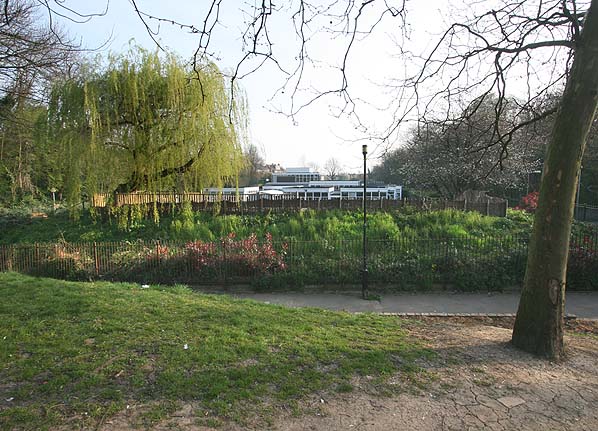




 Home Page
Home Page